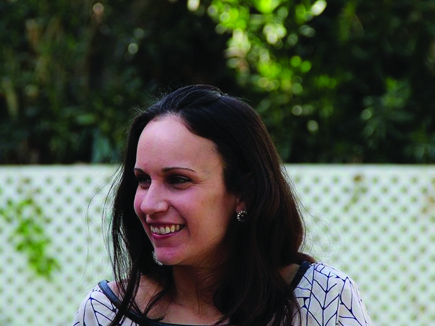Ruth Griswold Abrams
Sanofi, Bridgewater
Bridgewater, New Jersey
Department: Translational Informatics (Quantitative Systems Pharmacology)
Education: B.S. Applied Mathematics with Minors in Economics and Political Science, 2005, Columbia University (attended Caltech first two years); Ph.D. Computational Biology, 2015, Icahn School of Medicine at Mount Sinai and Courant Institute of Mathematical Sciences at New York University
Career stage: Mid-12 years post Bachelor’s(four spent in a different field)

What She Does
Ruth develops and utilizes quantitative systems pharmacology (QSP) models to better inform clinical trial design and decisions. QSP models encompass the important aspects of the disease biology needed to capture the drug’s mechanism of action and to connect this action to clinical outputs measured in patients. Typically, she works on models for 2–3 drugs over the same period. Each of these drugs can be at different stages of development, and there are different objectives for the models based on the clinical questions of interest.
Ruth’s responsibilities vary over the course of a model’s development, but include programming the model, researching the literature to resolve questions about what biology the model must include, discussing the model with other model developers and members of the clinical team to get feedback, running and analyzing simulations of the model, and helping to develop of a technique for creating virtual patient populations to use in model simulations.
Necessary Job Skills
Communication is very important in Ruth’s job, both to other model developers as they create the model, and to the clinical team, to make clear how the model predictions are useful. Programming skills in Matlab and R are important for implementing the model and running simulations. Some knowledge and background in both math and biology are needed so that she can understand how the biology works, and how to mathematically represent this biology.
Applied mathematics allows her group to represent the key components of a biological system in one framework, utilizing data on initial conditions and parameter values from different literature sources, so that they can systematically test the importance of each component in this larger context. Applied mathematics is also key to developing the methods needed to identify different patient subpopulations in clinical trial data, and to optimize the model to data from these subpopulations.
Pros and Cons Of Her Job
Ruth loves thinking about how biological ideas can be translated into mathematics, and what one representation vs. another would really mean. She loves being able to answer questions with a model that feel like solving a mystery and are very satisfying. On the negative side, it is a lot of work to handle such large models and requires long hours at times. Additionally, unlike in academia, your research focus is determined by the demands of the company and not your own preference.
Work/Life Balance
Most people at Ruth’s company have families and value their time with them. Employees have company laptops, so they can sometimes work from home 1–2 days a week.
The colleges I didn’t get into and jobs i didn’t get forced me to explore options I wouldn’t have considered otherwise. I wound up getting into a field and position best suited for my skills and where I am very happy.
Career Path
Math was always Ruth’s favorite subject and was an easy choice for a college major, but figuring out how to use it after college was challenging—she accepted a job at a company that created statistical reports for clinical trials. This work, along with a college internship that exposed her to mathematical modeling of tumor growth, shifted her interest to the field of computational biology.
Early in her career, Ruth took several classes after work, to supplement her knowledge of biology, bioinformatics, and computer programming, and did some independent research in bioinformatics with one of her professors. In graduate school, she collaborated with a math and a biology advisor for her thesis work on mathematical modeling of tumor growth.
Career Expectations and Advice
“Take the time to figure out what you really want to do.”
Don’t go into grad school without being sure that it is the field you want to work in and that it will be worth it to you to get through the challenges of completing the six years of your PhD.
Ruth did not expect to end up in computational biology. She took one biology class at Caltech and left with the impression that it was just about memorization. However, her attitude towards the field drastically changed as she gained exposure to biology, its various uses, and the diversity of biology research.
Don’t go into grad school without being sure that it is the field you want to work in and that it will be worth it to you.
Stay Up-to-Date with Email Alerts
Sign up for our monthly newsletter and emails about other topics of your choosing.

